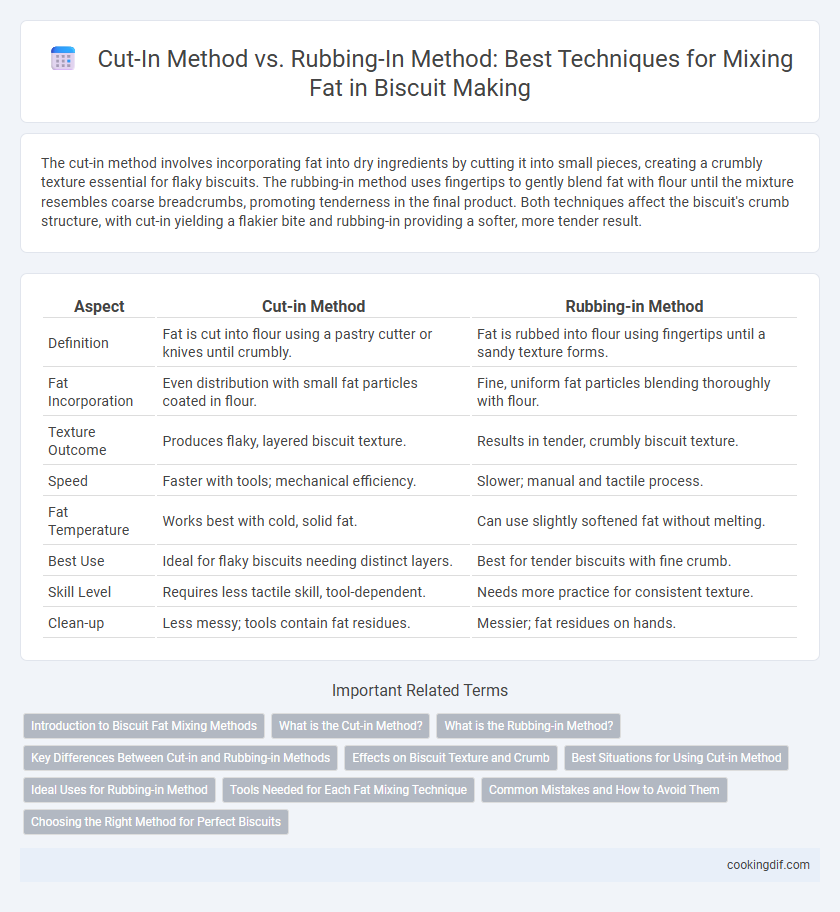The cut-in method involves incorporating fat into dry ingredients by cutting it into small pieces, creating a crumbly texture essential for flaky biscuits. The rubbing-in method uses fingertips to gently blend fat with flour until the mixture resembles coarse breadcrumbs, promoting tenderness in the final product. Both techniques affect the biscuit's crumb structure, with cut-in yielding a flakier bite and rubbing-in providing a softer, more tender result.
Table of Comparison
| Aspect | Cut-in Method | Rubbing-in Method |
|---|---|---|
| Definition | Fat is cut into flour using a pastry cutter or knives until crumbly. | Fat is rubbed into flour using fingertips until a sandy texture forms. |
| Fat Incorporation | Even distribution with small fat particles coated in flour. | Fine, uniform fat particles blending thoroughly with flour. |
| Texture Outcome | Produces flaky, layered biscuit texture. | Results in tender, crumbly biscuit texture. |
| Speed | Faster with tools; mechanical efficiency. | Slower; manual and tactile process. |
| Fat Temperature | Works best with cold, solid fat. | Can use slightly softened fat without melting. |
| Best Use | Ideal for flaky biscuits needing distinct layers. | Best for tender biscuits with fine crumb. |
| Skill Level | Requires less tactile skill, tool-dependent. | Needs more practice for consistent texture. |
| Clean-up | Less messy; tools contain fat residues. | Messier; fat residues on hands. |
Introduction to Biscuit Fat Mixing Methods
Biscuit fat mixing methods primarily include the cut-in method and the rubbing-in method, both crucial for achieving the desired dough texture. The cut-in method involves incorporating fat into flour by cutting it into small pieces, promoting flaky layers and an evenly distributed fat matrix. The rubbing-in method entails manually blending fat with flour until a sandy, crumbly consistency forms, essential for tender and crumbly biscuit structures.
What is the Cut-in Method?
The Cut-in method involves incorporating solid fat, such as butter or shortening, into flour using a pastry cutter, knives, or fingers until the mixture resembles coarse crumbs. This technique ensures even fat distribution, creating a tender and flaky biscuit texture by coating flour particles with fat. Unlike the Rubbing-in method, the Cut-in method emphasizes minimal handling to prevent gluten development, resulting in a light, crumbly biscuit structure.
What is the Rubbing-in Method?
The rubbing-in method involves incorporating fat into flour by physically rubbing the fat and flour together until the mixture resembles fine breadcrumbs, ensuring even fat distribution essential for biscuit texture. This technique promotes a tender, flaky crumb by coating flour particles with fat, preventing gluten overdevelopment during mixing. Compared to the cut-in method, rubbing-in offers more control over fat integration, resulting in superior biscuit consistency and crumb structure.
Key Differences Between Cut-in and Rubbing-in Methods
The cut-in method involves incorporating fat into flour using a pastry cutter or forks to create coarse, pea-sized lumps, which contributes to a flaky biscuit texture by creating steam pockets during baking. The rubbing-in method entails using fingertips to work fat directly into flour until the mixture resembles breadcrumbs, resulting in a more uniform fat distribution and a tender, crumbly biscuit crumb. Key differences include the tools used, texture outcomes, and fat integration technique, with cut-in favoring flakiness and rubbing-in promoting tenderness.
Effects on Biscuit Texture and Crumb
The cut-in method disperses fat into flour more uniformly, promoting a finer crumb and tender biscuit texture by creating smaller fat-coated flour particles. In contrast, the rubbing-in method produces larger fat pockets, resulting in a flakier texture with a coarser crumb structure. Selection between methods directly influences biscuit density, crumb softness, and overall mouthfeel.
Best Situations for Using Cut-in Method
The cut-in method is best suited for biscuit recipes requiring a tender, flaky texture, as it evenly distributes solid fat like butter or shortening into dry ingredients without overworking the dough. It works particularly well when precise control over fat particle size is needed, such as in layered or flaky biscuits. This method excels in cold environments where maintaining fat integrity is crucial for optimal biscuit rise and crumb structure.
Ideal Uses for Rubbing-in Method
The rubbing-in method is ideal for biscuit doughs requiring a tender, crumbly texture as it evenly distributes fat particles throughout the flour, creating small, flaky layers. This technique excels in recipes where minimal gluten development is desired, such as shortcrust and scones, producing a delicate crumb. Rubbing-in ensures the fat is incorporated without melting, preserving the lightness and enhancing the biscuit's structural integrity.
Tools Needed for Each Fat Mixing Technique
The Cut-in method for fat mixing in biscuit preparation requires a pastry blender or two knives to manually break down fat into flour, creating a crumbly texture essential for flaky biscuits. In contrast, the Rubbing-in method involves using fingertips or a food processor to blend fat with flour until the mixture resembles coarse breadcrumbs, relying on tactile control or mechanical action. Each technique demands specific tools that directly influence the dough's texture and the final biscuit quality.
Common Mistakes and How to Avoid Them
Common mistakes in the cut-in method for biscuit dough include overworking the fat, which leads to tough texture, and uneven distribution, causing inconsistent flakiness. In the rubbing-in method, failing to keep ingredients cold often results in melted fat, compromising biscuit rise and tenderness. To avoid these errors, use chilled fats, minimal handling, and distribute fat uniformly to ensure light, flaky biscuits with optimal texture.
Choosing the Right Method for Perfect Biscuits
Choosing the right fat mixing method significantly impacts biscuit texture, with the cut-in method producing flakier layers by evenly distributing cold butter into flour, while the rubbing-in method yields a tender crumb by gently blending fat until pea-sized crumbs form. Cut-in is ideal for classic flaky biscuits requiring distinct layers, whereas rubbing-in suits softer biscuits with a more uniform texture. Understanding the distinct fat incorporation techniques ensures optimal crumb structure and desired biscuit quality.
Cut-in method vs Rubbing-in method for fat mixing Infographic

 cookingdif.com
cookingdif.com